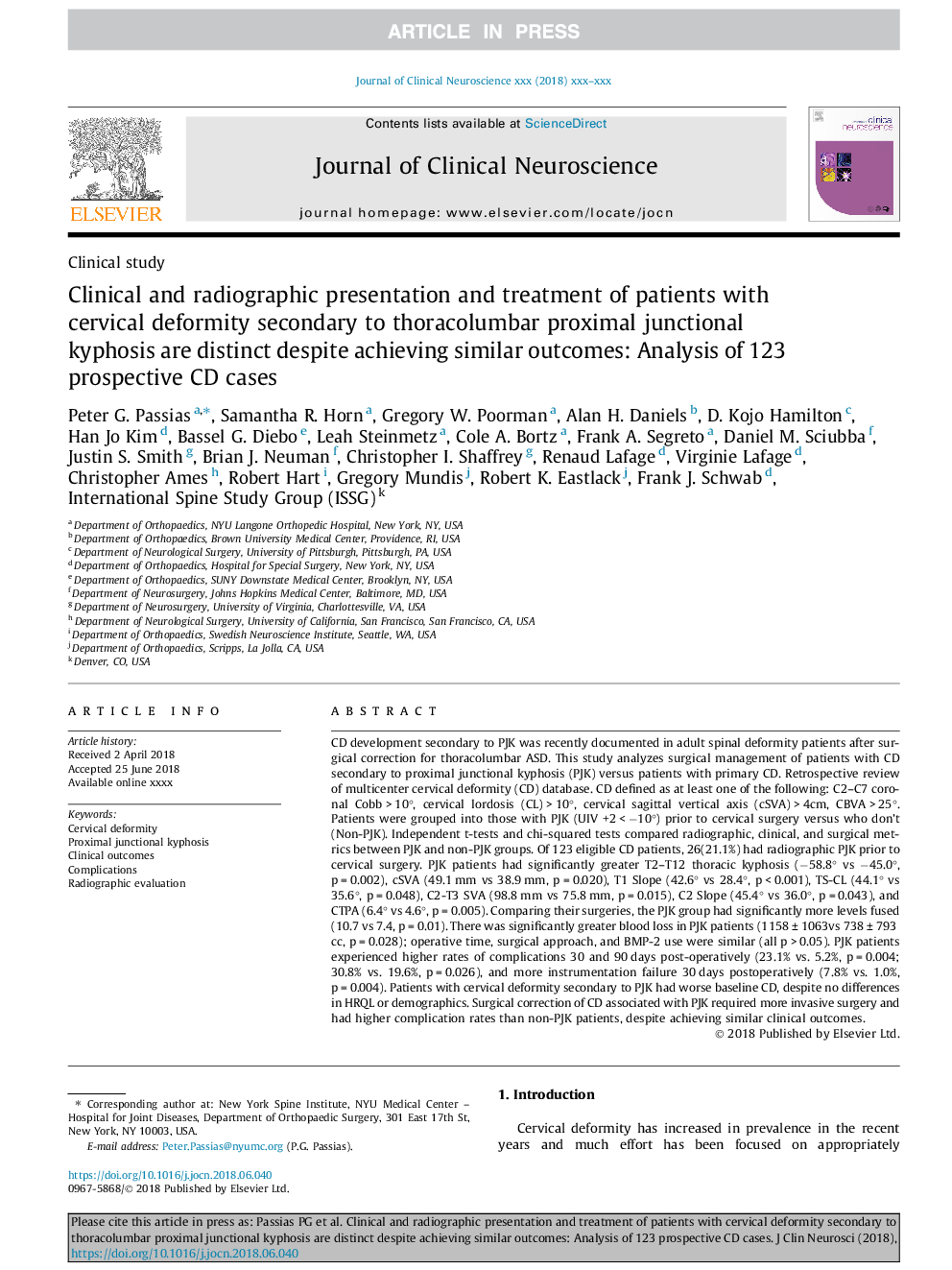| Article ID | Journal | Published Year | Pages | File Type |
|---|---|---|---|---|
| 11009516 | Journal of Clinical Neuroscience | 2018 | 6 Pages |
Abstract
CD development secondary to PJK was recently documented in adult spinal deformity patients after surgical correction for thoracolumbar ASD. This study analyzes surgical management of patients with CD secondary to proximal junctional kyphosis (PJK) versus patients with primary CD. Retrospective review of multicenter cervical deformity (CD) database. CD defined as at least one of the following: C2-C7 coronal Cobbâ¯>â¯10°, cervical lordosis (CL)â¯>â¯10°, cervical sagittal vertical axis (cSVA)â¯>â¯4cm, CBVAâ¯>â¯25°. Patients were grouped into those with PJK (UIV +2â¯<â¯â10°) prior to cervical surgery versus who don't (Non-PJK). Independent t-tests and chi-squared tests compared radiographic, clinical, and surgical metrics between PJK and non-PJK groups. Of 123 eligible CD patients, 26(21.1%) had radiographic PJK prior to cervical surgery. PJK patients had significantly greater T2-T12 thoracic kyphosis (â58.8° vs â45.0°, pâ¯=â¯0.002), cSVA (49.1â¯mm vs 38.9â¯mm, pâ¯=â¯0.020), T1 Slope (42.6° vs 28.4°, pâ¯<â¯0.001), TS-CL (44.1° vs 35.6°, pâ¯=â¯0.048), C2-T3 SVA (98.8â¯mm vs 75.8â¯mm, pâ¯=â¯0.015), C2 Slope (45.4° vs 36.0°, pâ¯=â¯0.043), and CTPA (6.4° vs 4.6°, pâ¯=â¯0.005). Comparing their surgeries, the PJK group had significantly more levels fused (10.7 vs 7.4, pâ¯=â¯0.01). There was significantly greater blood loss in PJK patients (1158â¯Â±â¯1063vs 738â¯Â±â¯793â¯cc, pâ¯=â¯0.028); operative time, surgical approach, and BMP-2 use were similar (all pâ¯>â¯0.05). PJK patients experienced higher rates of complications 30 and 90â¯days post-operatively (23.1% vs. 5.2%, pâ¯=â¯0.004; 30.8% vs. 19.6%, pâ¯=â¯0.026), and more instrumentation failure 30â¯days postoperatively (7.8% vs. 1.0%, pâ¯=â¯0.004). Patients with cervical deformity secondary to PJK had worse baseline CD, despite no differences in HRQL or demographics. Surgical correction of CD associated with PJK required more invasive surgery and had higher complication rates than non-PJK patients, despite achieving similar clinical outcomes.
Keywords
Related Topics
Life Sciences
Neuroscience
Neurology
Authors
Peter G. Passias, Samantha R. Horn, Gregory W. Poorman, Alan H. Daniels, D. Kojo Hamilton, Han Jo Kim, Bassel G. Diebo, Leah Steinmetz, Cole A. Bortz, Frank A. Segreto, Daniel M. Sciubba, Justin S. Smith, Brian J. Neuman, Christopher I. Shaffrey,
